Neighbourgardens
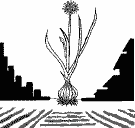
This project is not presently in operation.
However, City Farmer has an on-line site for neighbours who want to share garden space:
Sharing Backyards in Metro Vancouver.
Rae Blewden
Coordinator
To contact Rae about Neighborgardens, please contact us at City Farmer 604-685-5832.
Neighbourgardens is a non-profit organization with the mandate to enable and teach people how to feed and house themselves at costs everyone, and the environment, can afford by:
- Matching landless gardeners with unused neighbourhood gardening space.
- Providing elderly landowners with gardeners to share produce and cupa tea. Matching over-productive gardens with disabled 'buddies' to share produce. Teach 'no digging' methods of converting land/lawns into vegetable gardens.
- Hold organic vegetable growing classes for able-bodied and people with
- disabilities. See below for 2003 class outlines.
- Teach Cob House Building skills to enable people to build their own non-toxic
- homes for under $5,000. Volunteers needed to assist disabled students.
- Design and build Table Top Garden Beds for gardening from a wheelchair or stool.
- Publish and distribute Seed Saving in an Urban Garden.
The Coordinator
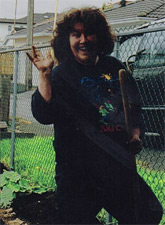
Rae Blewden is a single mother, recently graduated from Simon Fraser University, has 30 years bookkeeping and small business management experience and has been growing her vegetables in Vancouver gardens for 20 years.
Matching Gardeners and Landowners
Since 1999 Neighbourgardens has established over 2000 connections in the Greater Vancouver Area, between landowners who have garden space they do not have the ability or time to tend, and landless people wishing to have the use of a garden patch in their neighborhood to grow fresh vegetables to feed themselves and/or their families.
Neighbourgardens new 'Buddy Program' also matches disabled people with gardening knowledge, with other able-bodied or disabled people with complementary abilities (in groups of 2 or more, befitting the size of their garden) to assist each other. These Buddys are then be matched into private back yard gardens in their neighbourhood to grow good wholesome vegetables to feed themselves.
2002 Neighbourgardens also matched almost 100 over-productive gardeners with 'Buddies' with disabilities in their neighbourhood to share excess produce and perhaps a cup of tea.
The Benefits of Neighbourgardens Activities.
- The able and the physically unable fulfill each others needs. Gardeners are asked to either give a few veggies or do a little extra garden work for the land-owner as a gesture of thanks for the use of the land. Thus, for elderly landowners a gardener can be both a boon, and a friend.
- Gardeners coming and going at odd hours to water and tend their garden provide an element of both property and personal security. Vancouver Police advise that a well tended property with visitors at random times is a good deterrent to criminal invasions.
- Social, financial, religious, cultural, gender and age barriers are bridged.
- There is more equitable access to food resources.
- Children of landless families can be better fed at little cost.
- Precious urban green space is more responsibly nurtured.
Gardening Classes - Summary 2002
Three large wheelchair accessible vegetable gardens totaling c.4300'sq were created from sod or overgrown private back yards using 'no digging' permaculture methods this year by 50 students in three classes having a lot of fun. Moreover, in all the years I have been teaching these classes, I have never seen more healthy and abundant crops of organic vegetables than those grown by this years students. Classes running from the beginning of April to end of September included: 17 people with disabilities (5 in wheelchairs) and a wide array of people destressing after work.
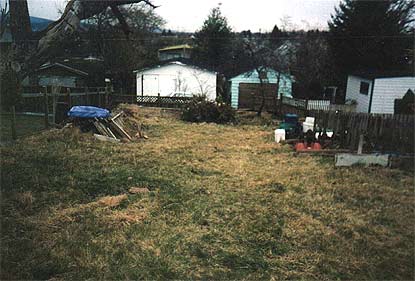
Main /25th Garden -
Before (April)
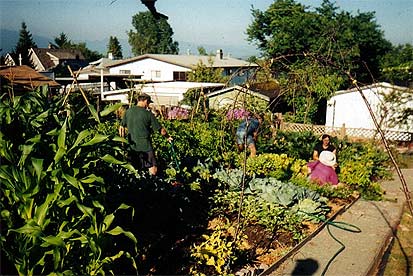
After (August)
2003 Classes
Garden Building and Organic Vegetable Growing (Main /25th)
This hands-on, weekday evening/afterwork class (day/time to suit the students enrolled) will start the first week of April and end whenever the crop is out around the end September. We will turn a sunny 15'x75' weed/lawn area into a natural woodsy vegetable garden using permaculture (no digging) methods, seeding / planting/ growing a crop of c.20 different organic vegetables learn to map what goes where and why, lay weed-less paths, work with landscape cloth, build a large herb rockery/logery inserted with ponds of edible plants, compost, organic pest control, watering, have fun, play with nature in the sunshine, harvest and take home a share of the crop. Tuition $350, Everything supplied.
Organic Vegetable Growing class for people with disabilities (Cambie/63rd)
Weekday afternoons May to September, Organic Vegetable Growing class for people with disabilities. Take home a share of the crop. By donation. Everything supplied. Wheelchair facilities available. Class full.
Neighbourgardens Cob Garden Shed Building Classes 2003
Learn to build your own home for under $5,000 !!!
Neighbourgardens will hold three Cob (earth) House Building Classes on Wednesdays 12.30 - 2.30, Thursdays 12.30 - 2.30 (this class is full), and Thursdays 5.30 - 8pm rain or shine (indoor lectures held on rainy days), from February 5th to completion around end September. These hands-on classes will teach all the basic skills to enable students to go on to build their own homes, at costs they can afford, from non-toxic recycled resources readily available in any urban area. Students will gain hands-on experience: digging foundations; installing a drainage system; building the foundations; cobbing 1' thick curved walls; inserting door and stained glass windows, attaching the roof structure; covering walls and floor with clay slip (similar to adobe) and possibly laying in a mosaic floor, by building a Cob garden shed (similar to pictured) for the residents of George Pearson Center (a long term facility for the disabled at Cambie/ W57th, Vancouver). Class will also cover some info on alternate energy sources (solar/windmill).
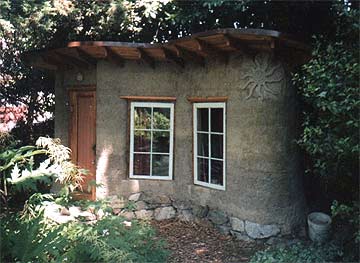
The purpose of this class is to not only teach the practical building skills, but promote a new awareness: that people Can build their own homes them-selves; that houses do Not need to be expensive, square, and built by professionals of toxic materials. They can have stronger, beautifully curved, earthquake resistant walls, constructed of non-toxic materials, and be heated by fireproof passive solar thermal mass. A much more sustainable living paradigm.
Tuition: $500 tx incl. people with disabilities by donation. Everything supplied. Wheelchair accessible. Phone early for details/registration.
What is Cob?
- Cob is an ancient building method using earth, clay, sand, and straw.
- Over 50% of the global population live in earth structures.
- Thousands of cob houses in England's damp climate have been
- continuously occupied for over 500 years.
- Cob foundations are made of recycled broken concrete and/or rock.
- Cob structures have self-supporting, load bearing walls 1-2 feet thick
- (depending in the number of stories they are carrying).
- Cob's sculptability makes it conducent to building curved walls, niches,
- arched doors and windows.
- Cob's curved walls are stronger than brick or block as they have no weak
- straight line mortar joints.
- Cob's continuous reinforcement network of straw holds the structure
- together as one monolithic mass.
- Because cob structures are one monolithic unit with curved walls it is
- the most earthquake resistant building method known.
- Cobs thermal mass creates passive solar structures that are cool in
- summer and warm in winter.
- Cob's porous nature (unlike adobe) makes it resistant to weathering.
- Cob allows for add-ons, cut-outs, and reshaping at any time.
- Cob dries to the hardness of concrete.
- Cob structures are fireproof.
- Cob building requires no power tools.
- Cob is non-toxic and completely recyclable.

To enable people in wheelchairs to grow their own vegetables Neighbourgardens has designed and built solid cedar Table-Top Garden Beds, 72"Lx40"Wx10" soil base, with specially contoured sides to allow easy wheelchair access from both sides. A portable greenhouse attachment allows for winter gardening and a specially designed drainage system conducts the earth's electro-magnetic energy up into the garden bed to provide the gardener with the same therapeutic value that is normally derived from gardening directly in the ground. Emailable schematics and building instructions are available for anyone who wishes to build there own.
Saving Vegetable Seeds in an Urban Garden
Saving Vegetable Seeds In an Urban Garden is a 'how to' book for urban gardeners who want to ensure the availability of open-pollinated seeds uncontaminated by modern day engineers. This book is also especially helpful for the increasing number of people and children, like my daughter, who have allergies to pesticides, herbicides, and the 'cillin' family of antibiotics used in genetically engineered seeds and food.
After DuPont (the second largest American Genetic Engineering Company next to Monsanto) purchased Pioneer Hi-Bred International Seed Company for $7.7billion in the mid 1990s almost 100% of the open-pollinated seed industry was firmly in the hands of five Multinational genetic engineering companies. Since then, these five companies have pressured governments to have open-pollinated seeds, that have sustained humanity faithfully for thousands of years, listed as unacceptable plant varieties, while GE/GM seeds are presented as the 'green' solution to feeding the world's population. Moreover, since they are not required to label seeds, seedlings, plants or foodstuffs with any GE or GM designations, knowing your seed supplier and/or the environment from which your vegetable seeds are derived takes on new importance.
Most seed saving books state "To avoid problematic cross-pollination gardeners must distance their seed-bearing vegetable plants from their neighbour's crop by one quarter to twenty miles". This, of course, is just not possible in an urban environment. So, Saving Vegetable Seeds In an Urban Garden outlines simple ways to isolate seedheads, hand pollinate over 100 different vegetable plants, save and store vegetable seeds for future harvests. If you would like a copy for yourself or a gift, phone or Email me and it will be mailed for only $7.95 plus $3.05 postage.

![[new]](new01.gif)
